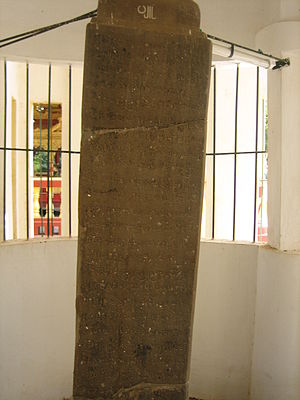lingvo.wikisort.org - Alphabet
The Pyu script is a writing system used to write the Pyu language, an extinct Sino-Tibetan language that was mainly spoken in present-day central Burma. It was based on the Brahmi-based scripts of both north and south India. The best available evidence suggests that the Pyu script gradually developed between the 2nd and 6th centuries CE. The Pyu script's immediate precursor appears to be the Kadamba script of southwest India. The early period Pyu inscriptions always included interlinear Brahmi scripts. It was not until the 7th and 8th centuries that Sri Ksetra's inscriptions appeared all in the Pyu script, without any interlinear Brahmi.[1]
| Brahmic scripts |
|---|
| The Brahmic script and its descendants |


Many of the important inscriptions were written in Sanskrit and Pali, alongside the Pyu script. The Pyu sites have yielded a wide variety of Indian scripts ranging from Ashokan Brahmi script and Tamil Brahmi script, both dated to the 3rd and 2nd centuries BCE, to the Gupta script and Kannada script dated to the 4th to 6th centuries CE.[1][2]
The Pyu script is presently not in Unicode. Its inclusion was proposed in 2010,[3] and has tentative placement in the Unicode Consortium's roadmap.[4]
Notes
- Aung-Thwin, pp. 35–36
- Harvey, p. 4
- Pandey, Anshuman (5 August 2010). "Preliminary Code Chart and Names List for the Pyu Script" (PDF). Unicode Consortium. Retrieved 16 January 2016.
- Michael Everson; Rick McGowan; Ken Whistler; V.S. Umamaheswaran (17 August 2015). "Roadmap to the SMP". Retrieved 16 January 2016.
External links
References
- Aung-Thwin, Michael (2005). The mists of Rāmañña: The Legend that was Lower Burma (illustrated ed.). Honolulu: University of Hawai'i Press. ISBN 978-0-8248-2886-8.
- Harvey, G. E. (1925). History of Burma: From the Earliest Times to 10 March 1824. London: Frank Cass & Co. Ltd.
На других языках
[de] Pyu (Schrift)
Die Pyu-Schrift ist ein Schriftsystem, das zum Schreiben der Pyu-Sprache verwendet wurde, einer ausgestorbenen Sinotibetische Sprache, die hauptsächlich im heutigen zentralen Burma gesprochen wurde. Sie basierte auf den Brahmi-basierten Schriften sowohl Nord- als auch Südindiens. Die besten verfügbaren Beweise legen nahe, dass sich die Pyu-Schrift zwischen dem 2. und 6. Jahrhundert n. Chr. allmählich entwickelte. Der unmittelbare Vorläufer der Pyu-Schrift scheint die Kadamba-Schrift Südwestindiens zu sein. In der frühen Periode enthielten die Pyu-Inschriften immer interlineare Brahmi-Schriften. Erst im 7. und 8. Jahrhundert erschienen die Inschriften Sri Ksetras alle in der Pyu-Schrift, ohne interlineares Brahmi.- [en] Pyu script
Другой контент может иметь иную лицензию. Перед использованием материалов сайта WikiSort.org внимательно изучите правила лицензирования конкретных элементов наполнения сайта.
WikiSort.org - проект по пересортировке и дополнению контента Википедии
